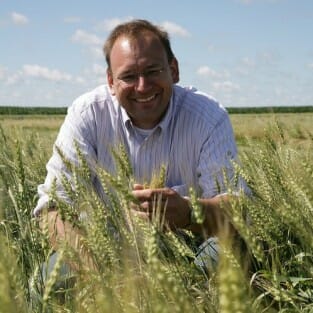Small Grains Expert Wiersma Talks Growing Profitable Small Grains in Iowa
“Since the last people to grow small grains in this area were our grandparents or our great-grandparents a lot of small grains production [knowledge] seems like it’s through story telling. Some people say, well I’ve heard from my grandfather, that if you let small grains go down, it means they have a higher test weight. Is that true? Is that a myth? One would only know through many years of experience.” – Farmer Wendy Johnson of Jóia Food Farm and Vice President of the Practial Farmers Board of Directors
To help farmers like Wendy sort through the truth and the myths about farming small grains, we sought out someone with many years of experience. Small grains specialist Jochum Wiersma from University of Minnesota Extension gave a session at the Practical Farmers’ Annual Conference titled “Growing Profitable Small Grains in Iowa.” One of the stories Wendy has heard is that farmers in her area used to grow oats after corn, heading into the session last week she hoped to learn from an expert if this was a good practice.

Small Grains Specialist Jochum Wiersma from the University of Minnesota Northwest Research and Outreach Center. Photo: https://twitter.com/jochumwiersma
The session began with audience participation as Wiersma asked the 117 attendees to repeat after him: “I. Shall. Never. Ever. Plant. Small. Grains. After. Corn.” He stressed that this is the surest way to avoid toxicity and yield loss caused by Fusarium Head Blight. It’s also often necessary because of herbicide restrictions. Wiersma elaborated, “in conventional ag we have to worry about carry over issues with herbicides sprayed before small grains . . . In some cases you’re talking 18 months, and if you have dry and sandier soils that’s going to be even more extended.” Planning rotations and herbicide applications well in advance (months or even years rather than weeks) is often crucial to growing profitable small grains.
Wendy reflects, “in regards to my question about oats after corn the answer was a resounding no! [Dr. Wiersma] was a great speaker with both an education and research background.”
Wiersma’s presentation was full of important technical details about growing small grains. To really dig in, peruse his slides which will be loaded onto our Annual Conference Multimedia page in the next couple of weeks. Here’s a cheat sheet of his top tips to tide you over until the full presentation goes up:
- Pick top yielding variety from regional trial data taken at multiple locations.
- Seed early. Don’t wait until soil temperature is 40 degrees; seeding over frost is not a problem.
- Seeding rate of 1.3 million viable seeds/acre is ideal. If you plant late, seed a higher population to make up for lost tillers. Rows no wider than 6-7 inches.
- “Calibrate your damn drill” – a successful small grain harvest is all about population!
- Seed about 1.5 inches deep. Drive slow when planting – it may be tedious, but if you speed the planting depth will be variable so you won’t get uniform stands.
To learn more about growing small grains check out Practical Farmers’ Rotationally Raised video series and stay tuned on our blog for more updates from our small grains shared learning calls held from 12:00-1:00 PM every first Friday of the month. If you’re interested in joining the shared learning calls email me at alisha@practicalfarmers.org.
